서 론
당뇨병은 경제적 성장에 따른 전 세계적으로 심각한 대 사성 질환으로 대두되었다. 2011년 국제 당뇨병 연맹의 자 료에 따르면 전 세계적으로 당뇨병 환자의 수가 3억 6천명 에서 2030년에는 5억 5천명으로 증가될 것으로 예측하고 있다(1). 대한민국 통계청에 따르면 당뇨병에 의한 사망률 이 2000년도 6위에서 2013년도에는 인구 10만 명당 21명으 로 사망원인의 5위를 차지하였으며 전 국민의 약 10%가 당뇨병 환자로 보고되고 있다(2). 당뇨병은 그 원인에 따라 췌장 베타세포가 인슐린을 생산하지 못해 발생하는 제 1형 당뇨병과 인슐린이 상대적으로 부족하거나 인슐린 저항성 이 커서 인슐린이 제 기능을 하지 못하여 발행하는 제 2형 당뇨병으로 분류할 수 있으며(3,4) 현재 당뇨병 환자의 85% 이상이 제 2형 당뇨병이다(5). 현재 임상에서 이용되는 경구 용 당뇨병 치료제 및 인슐린제제는 혈당 조절에만 초점이 맞춰져 있으며 저혈당, 간독성, 체중증가 등의 부작용을 유발하기 때문에 이를 최소화 하며 당뇨병을 근본적으로 치료할 수 있는 혈당 강하 소재의 개발이 필요하다(6).
포도당 수송체(GLUTs, glucose transporter)는 인슐린에 의해 조절되어 혈액에서 세포 내로 포도당을 이동시키는 중요한 역할을 수행하며(7) GLUT-1,2,3,4,5,7의 isoform이 존재한다(8). 특히 GLUT4(glucose transporter 4)는 주로 골 격근이나 지방조직에서 발견되고, 대부분 세포질 내에 위 치해 있다가 인슐린에 의해 세포막으로 이동하여 포도당 흡수를 증가시키는데 이 현상을 GLUT4 translocation이라 한다(9-11). 포도당이 체내에 유입되면 인슐린이 분비되어 세포막의 insulin receptor(IR)와 결합하여 세포 내에 존재하 는 tyrosine kinase를 활성화 시키고, 인슐린 기질단백질인 insulin receptor substrate 1(IRS1), insulin receptor substrate 2(IRS2)이 결합하여 인산화 된다. 이렇게 인산화 된 IRS1은 phosphotidylinositol 3-kinase(PI3K), phosphatidylinositol 3,4,5-trisphosphate, Akt를 순차적으로 인산화 및 활성화시 킨다. Akt의 인산화는 GLUT4 translocation을 증가시켜 혈 당을 조절한다(12-16). 또한 골격근 세포 내의 adenosine monophosphate activated protein kinase(AMPK)가 인산화되 어 지방산 산화와 당 흡수를 촉진시키고 GLUT4의 발현을 유도하여 혈당을 조절한다(17). GLUT4 유전자 발현은 전 신 인슐린 민감성에 영향을 미치는 것으로 확인 되었으며 GLUT4 유전자 발현 이상은 인슐린저항성의 첫 단계로 여 겨진다(18).
Ceriporia lacaerata는 구멍장이버섯목(Polyporales) 유색 고약버섯과(Phanerochaetaceae)의 버섯으로 목재의 셀룰로 오스, 헤미셀룰로오스, 리그닌 등을 분해하는 백색 부후균 (19)으로C. lacerata P2 균사체의 크리스탈 바이올렛 제거 (20), dimethyl phthalate의 생분해(21)에 관한 연구 등이 보 고되었다. 의약학적 연구로C. lacerata 균사체 배양액 추출 물의 제1형 당뇨병 쥐에서의 항당뇨 효과(22), C. lacerata 균사체 배양물의 제2형 당뇨에서의 효과와 세포 수준에서 의 기전 연구(23)가 보고되었다. 이에 본 연구에서는 C. lacerata 균사체 배양물의 제 2형 당뇨병 동물모델에서의 기전을 연구하기 위하여C. lacerata 균사체 배양물을 농축 건조하여 제 2형 당뇨병 동물에서 혈당, 인슐린, c-peptide 등을 분석하고, 인슐린 신호 전달 기전 상의 유관 단백질 및 mRNA 발현을 분석하였다.
재료 및 방법
본 실험에 사용한 균주는 ㈜월드바이오텍(World Biotech Co., LTD., Sangju, Korea)에서 보유한C. lacerata 균사체를 potato dextrose agar(PDA, Difco. Co., Maryland, USA) 배지 에 접종하여 25℃에서 9일 동안 배양하여 사용하였다. C. lacerata 균사체를 전분 4 g/L, 포도당 20 g/L, 정제수 600 mL을 혼합하여 만든 액체 배지에서 pH 5, 온도 23℃, 회전 속도 300 rpm으로 10일 동안 전배양하였다. 전배양이 종료 된 균사체 배양액을 설탕 12.5 g/L, 탈지대두분 2.5 g/L, 소포제 0.125 g/L, 정제수 400 L를 혼합하여 만든 액체 배지 에 옮겨 pH 5, 온도 23℃, 공기주입량 1.0 kgf/cm2, 회전 속도 100 rpm으로 9일 동안 배양하였다. 배양한C. lacerata 균사체 배양물을 농축 건조(CL01)하여 건조 중량을 기준으 로 각 실험군의 용량에 맞게 사용하였다. 실험에 사용된 metformin은 다림바이오텍 사(Glupa Tab. 500 mg, Seoul, Korea)로부터 구입하여 사용하였고, GLUT4, IRS1, Akt2, beta-actin primer는 제노텍(Daejeon, Korea)에서 구입하였 고, p-IR, p-PI3K, p-Akt, p-AMPK, GLUT4 항체 및 그 외 시약은 Sigma Chemical Co.(St. Louis, MO, USA)에서 구입 하였다.
GLUT4 유전자 발현을 평가하기 위해 마우스 근육세포 (C2C12 myoblast)를 American Type Culture Collection (ATCC; Manassas, VA, USA)으로부터 분양 받아 사용하였 다. C2C12 myoblast 세포를 2×104 cells/mL로 10% FBS를 첨가한 고농도 glucose(4.5 g/L) DMEM 배지에서 37℃, 5% CO2로 조정된 CO2 배양기에서 72 시간 동안 배양한다. 세포 가 약 80% confluent 해졌을 때 2% horse serum이 첨가된 DMEM배지로 교환한 후 4일간 배양하여 근육세포로 분화 하였다(24). 분화한 세포를 6 well plate에 1×106 cells/mL로 분주하여 CL01을 각각 100, 250, 500 μg/mL로 처리하여 24시간 배양 후 세포를 수거하여 PCR을 수행하였다.
실험동물은 5주령의 수컷 C57BLKS/J-db/db 마우스 (Central Lab. Animal Inc., Seoul, Korea)를 구입하여 7일간 순화시킨 뒤 실험에 사용하였다. 동물은 온도 23±3℃, 상대 습도 55±15% 및 12시간 명암주기로 조절되는 환경에서 사육하였다. 실험동물은 케이지당 3마리 이하로 배치하여 사육하였으며, 실험기간 동안 사료는 Teklad certified irradiated global 18% protein rodent diet(2918C, Harlan Co., Ltd., Indiana, Indianapolis, USA)를 자유 급이하였고, 음수 는 여과된 살균 정제수를 자유롭게 섭취시켰다.
각 실험군당 5마리씩 절식 혈당을 측정하여 각 군의 평균 혈당값이 균등하게 되도록 무작위 배치하였다. 실험군은 음성대조군(멸균주사용수(Daihan Pharm Co., Ltd., Seoul, Korea))(G1), CL01 300 mg/kg 투여군(G2), 양성대조군(메 트포민 300 mg/kg)(G3)으로 구성하여 4주간 사육하였다. CL01 투여군은 CL01을 멸균주사용수(Daihan Pharm Co., Ltd., Seoul, Korea)에 녹여 경구 투여용 존데와 주사기를 이용하여 10 mL/kg를 투여하였고, 음성대조군과 양성대조 군은 각각 동일한 용량의 멸균주사용수와 멸균주사용수에 녹인 메트포민을 경구 투여하였다. 4주 동안 주 1회 체중 및 혈당을 측정하였다. 혈당은 미정맥에서 혈액을 채취하 여 glucometer(G-Doctor, AllMedicus Co., Ltd., Anyang, Korea)로 측정하였다. 동물실험은 경기바이오센터 동물실 험윤리위원회(Institutional Animal Care and Use Committee, IACUC)의 승인 하에 수행하였다.
실험 종료 후, 실험동물을 4시간 절식시키고 isoflurane으 로 마취하여 개복한 후 후대정맥에서 혈액을 채취했다. 채 취한 혈액을 clot activator가 들어있는 vacutainer tube에 넣 어 실온에서 30분 이상 응고시킨 후 원심분리(4,000×g, 10 min)하여 혈청을 새 tube에 담은 후 분석을 위해 –70℃에서 보관하였다. 포도당 농도는 혈액생화학기기(Adiva 2120, SIEMENS, Munich, Germany)를 이용하여 측정하였고, insulin 및 c-peptide는 각각의 kit(AKRIN-011T, AKRCP-031, Shibayagi, Japan)를 이용하여 측정하였다. 측정한 포도당, insulin 농도를 이용하여 인슐린 저항성을 나타내는 Homeostatic Model Assessment-Insulin Resistance(HOMA-IR) 는 Matthews 등(24)의 방법으로 계산하였다.
채혈이 끝난 실험동물의 다리의 비복근 및 가자미근을 적출하였다. 적출한 근육을 잘게 분쇄하여 lysis buffer를 이용하여 protein을 분리하였다. 분리한 protein을 BSA kit를 이용하여 protein을 정량하고 동일한 protein 양으로 희석하 여 acrylamide gel에 전기영동하고 nitrocellulose membrane 에 옮긴 후 일차 항체 pIR, pAkt, pAMPK 및 GLUT4로 반응시켰다. Membrane 수세 후 이차 항체로 한 시간 동안 반응시키고 ECL solution kit이 포함된 용액에 1분간 반응시 킨 후 Chemidoc(Proteinsimple, FlowChem®, Düsseldorf, Germany)으로 단백질 발현을 분석하였다.
Western blot 시 적출한 근육 15 mg 및 CL01을 처리한 C2C12 세포를 각각 trizol을 사용하여 total RNA를 추출한 후 NanoVueplus spectrophotometer(GE healthcare, Wisconsin, USA)를 이용하여 정량하고 Reverse transcription mixture (Improm-Ⅱ, Promega, Wisconsin, USA)을 이용하여 cDNA 를 합성하였다. cDNA를 합성한 후 세포 내 포도당 수송에 특이적인 primer(Table 1)을 이용하여 각각의 조건(Table 2)으로 PCR을 수행하였다.
결과 및 고찰
마우스 근육세포에서 CL01 처리에 따른 GLUT4 mRNA 발현양을 확인한 결과(Fig. 1), 근육세포에 CL01을 각각 100, 250, 500 μg/mL로 처리했을 때 GLUT4 유전자가 음성 대조군 대비 각각 약 180%, 178%, 189%(p<0.01) 발현되었 다. 본 연구에서 CL01 처리를 통해 근육세포에서 GLUT4 mRNA 발현이 증가하는 것을 확인하였다.

4주간 CL01 투여에 따른 체중 변화를 살펴보기 위해 주 1회 체중을 측정하였다(Table 3). 체중 측정 결과, 모든 실험군에서 유의적인 변화가 관찰되지 않았으며 실험 기간 내내 체중이 증가하는 경향을 보였다. 실험기간 동안의 혈 당 변화를 측정하기 위해 주 1회 체중 측정 후 혈당을 측정 하였다(Fig. 2). 투여 1주차에 CL01 투여군의 혈당이 증가하 여 음성대조군과 혈당 수치가 비슷하지만 2주차부터 혈당 이 감소하여 음성대조군보다 약 12.3% 혈당 수치가 낮게 측정 되었고, 시험 종료 시 양성대조군의 약 110% 수준 (475.40±31.16 mg/dL)으로 감소하였다. 4주간의 혈당 변화 를 관찰한 결과, CL01이 전문 혈당강하제에 비해 속효성은 낮으나 장기 투여 시 전문 혈당강하제의 약 66% 수준의 혈당 강하 효력이 있는 것을 알 수 있었다.
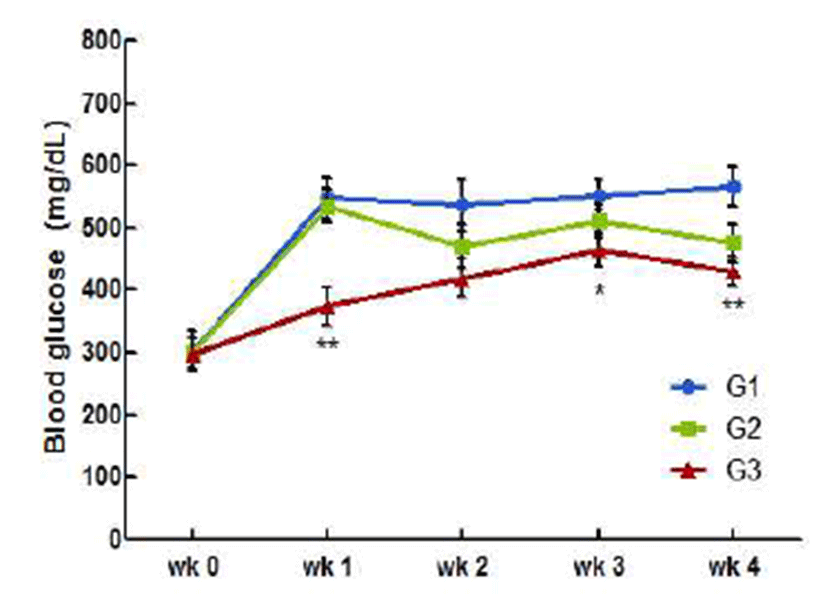
시험 물질 섭취 4주 후 동물을 희생하여 혈장 내 혈당, 인슐린, c-peptide 농도를 측정하고, HOMA-IR 수치를 계산 하였다. 먼저, 혈장 내 혈당 수치를 살펴보면 음성대조군에 비해 양성대조군은 유의적으로 혈당이 감소하였고 (p<0.05), CL01 투여군에서 유의성은 나타나지 않았지만 소폭 감소하였다(Fig. 3). 혈장 내 인슐린 농도를 측정한 결과, 양성대조군의 경우, 음성대조군 대비 약 65% 감소하 여 1.43±0.29 ng/mL(p<0.05)의 농도를 나타냈고, CL01투여 군의 경우, 음성대조군 대비 인슐린 농도가 약 55.8% 감소 하여 1.83±0.47 ng/mL(p<0.05)의 농도를 나타냈다(Fig. 4). 혈장 내 c-peptide 결과를 살펴보면 4주간 시험물질 투약 후 인슐린 농도의 감소와 유사한 형태로 감소한 것을 알 수 있다. 시험 종료 후 양성대조군의 c-peptide 농도는 음성 대조군의 약 20% 수준인 87.56±28.50 pg/mL(p<0.01)의 농 도를 나타냈고, CL01 투여군에서는 음성대조군의 약 40% 수준인 172.69±54.72 pg/mL(p<0.05)의 농도를 나타냈다 (Fig. 5). 분석한 혈액생화학적 지표를 이용하여 인슐린 저 항성을 반영하는 지표인 HOMA-IR 수치를 계산한 결과, 양성대조군에서는 음성대조군 대비 약 74% 인슐린 저항성 이 개선되었고(p<0.01), CL01 투여군에서는 음성대조군 대 비 약 62% 개선되었다(p<0.05)(Fig. 6). 혈장 내 인슐린과 c-peptide 농도는 인슐린 분비의 지표이며, 동시에 인슐린과 c-peptide는 proinsulin의 구성 요소이다. Proinsulin이 분해 되면서 생기는 인슐린은 혈중 안정성이 낮아 분해가 잘 되는 반면 c-peptide는 혈중 안정성이 높아 장시간에 걸친 인슐린 분비능을 확인하는 지표로 활용 가능하다(25). 인슐 린 저항성은 혈당은 동일하되 인슐린 수치가 상이한 서로 다른 개체에서 동일한 혈당을 유지하는데 더 많은 인슐린이 필요하여 그만큼 단위 인슐린의 작용이 떨어졌다는 것을 의미한다(26). 제 2형 당뇨병 환자의 90% 이상에서 인슐린 저항성이 생겨 고인슐린혈증이 유발되고(27), 당내성 장애, 당뇨병, 고혈압, 비만 등의 인슐린 저항성 증후군 유병률이 인슐린의 농도가 증가할수록 증가하며 인슐린 농도가 낮은 경우보다 대사 이상이 생길 확률이 증가한다(28). 본 연구에 서는 CL01의 섭취에 따라 인슐린 저항성이 개선되며 그에 따라 인슐린, c-peptide 및 혈당을 낮추는 것을 알 수 있다.
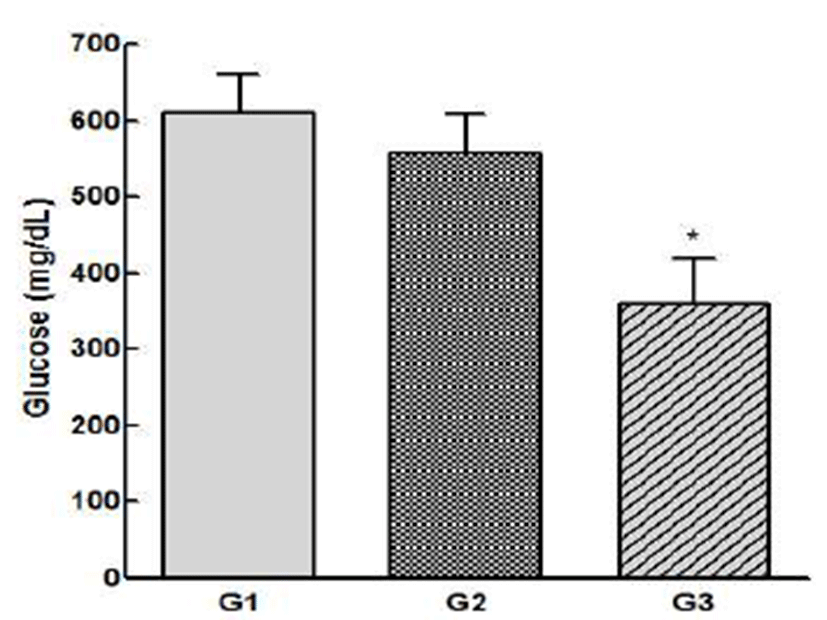
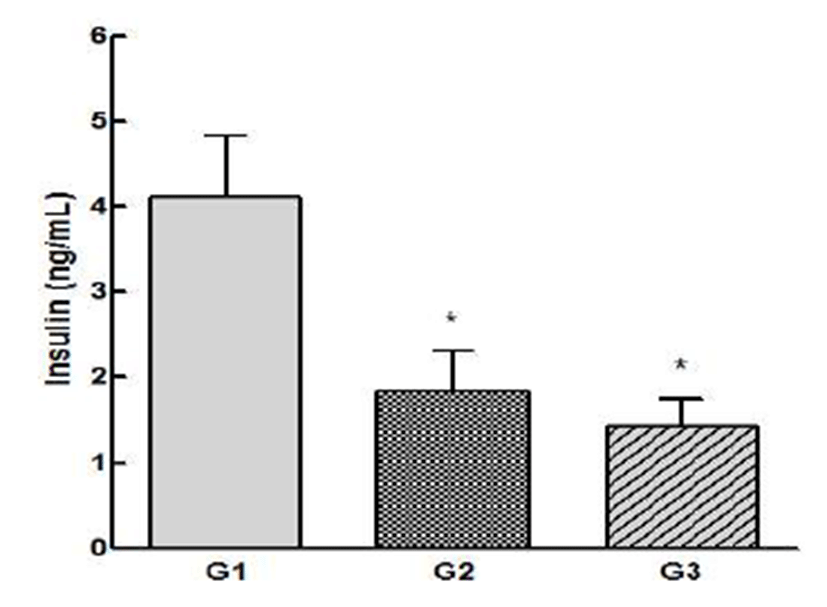
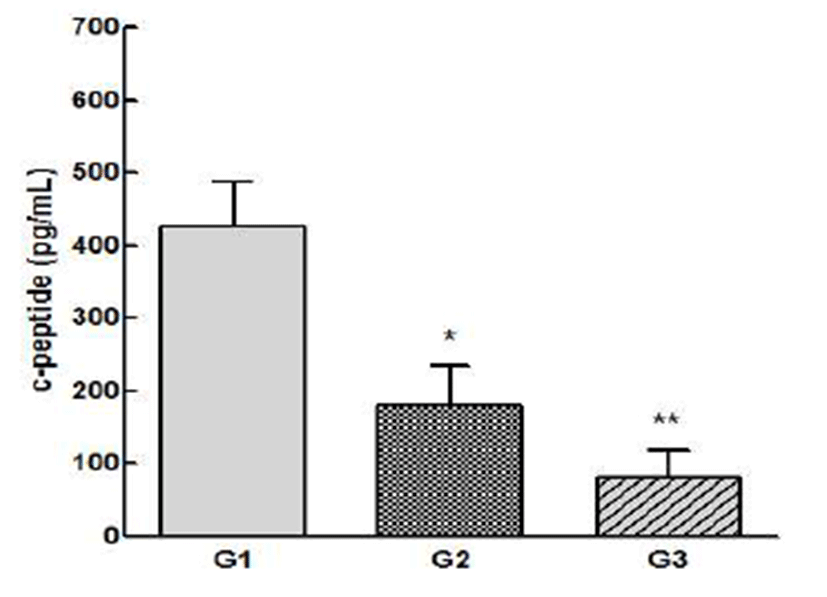
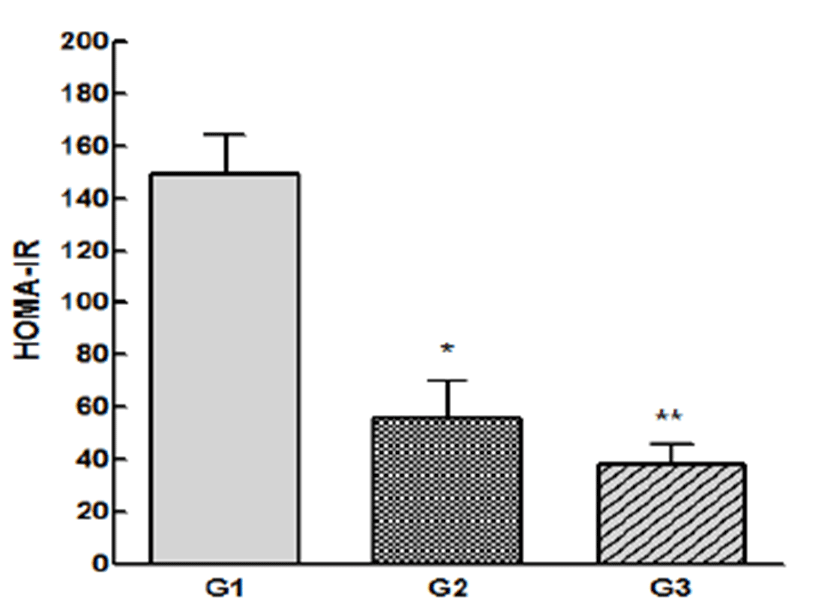
CL01이 근육세포에서 포도당 수송체 발현에 미치는 영 향을 확인하기 위해 시험 물질을 4주간 투여 후 동물을 희생하여 근육세포를 채취하여 포도당 수송체 발현에 관여 하는 유관 단백질 및 mRNA 발현을 측정하였다. Western blot으로 근육세포에서의 단백질을 측정한 결과(Fig. 7), CL01 투여군과 양성대조군에서의 pIR, pAkt, pAMPK 및 GLUT4 단백질 발현이 음성대조군과 비교하여 증가하였 다. 특히 CL01 투여군에서의 pAkt와 GLUT4 단백질 발현양 이 양성대조군 대비 각각 약 10%, 23.6% 증가하였고, pIR와 pAkt 그리고 GLUT4 단백질의 발현양이 음성대조군 대비 각각 약 153%, 145%, 167%(p<0.01) 수준으로 발현되었다. mRNA 발현양을 확인한 결과(Fig. 8), CL01 투여군과 양성 대조군에서의 Akt2, IRS1 및 GLUT4 발현이 음성대조군과 비교하여 증가하였고 CL01 투여군에서의 Akt2와 IRS1이 음성대조군 대비 각각 약 129%, 149%(p<0.05) 발현되었다. 본 연구에서 CL01 섭취를 통해 포도당 수송체 발현과 관련 된 단백질 및 mRNA 발현이 증가하였으며 그에 따라 GLUT4의 발현이 증가하여 혈당 감소에 영향을 미친 것을 확인할 수 있었다. 그리고 CL01 섭취 시 인슐린을 통한 IR의 인산화(pIR)에 도움을 주어 IRS1, Akt2, GLUT4의 유 전자 발현이 연속적으로 이루어져 GLUT4 translocataion을 증가시켜 혈당 감소 효과를 보이며 이는 양성대조군으로 사용한 메트포민과 유사한 기전으로(30), 인슐린에 의한 당 흡수 증가 기전과 다르게 AMPK 활성으로 인한 GLUT4 증가에서 기인한 세포내 당 유입 촉진에 따른 혈당 강하를 확인할 수 있었다. 일반적으로 담자균류에 속하는 버섯의 β-glucan, heteroglyca, galactan 등의 비소화성 수용성 다당 류가 혈당 강하에 우수한 효능을 나타내는 성분으로 알려져 있고(31,32), Kim 등의 연구(33)에서는C. lacerata 균사체 배양 대사산물인 세포외다당체 성분이 인슐린 분비 세포를 덱사메타손의 독성으로부터 보호한다고 보고된 바 있다. 상기의 결과에 비추어 볼 때C. lacerata 균사체 배양 대사산 물인 다당류 등이 항당뇨 활성을 나타내는 것으로 추측할 수 있으며 추후 C. lacerata 균사체 배양물의 기능 성분을 규명하기 위한 기초 증거로 활용할 수 있을 것이다.
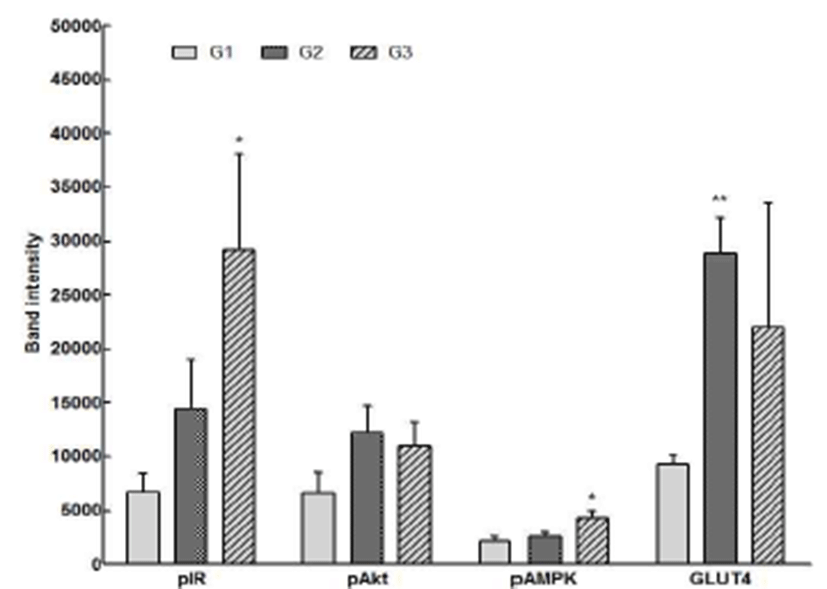
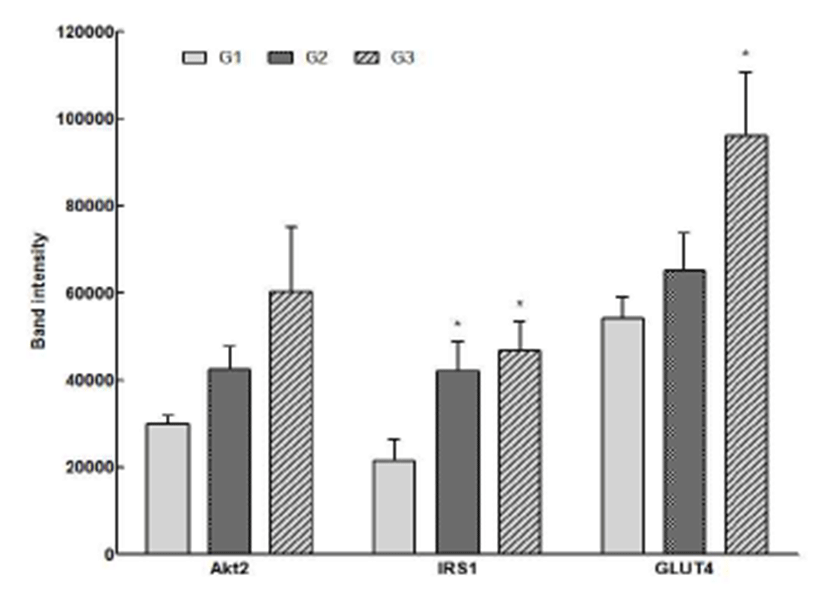
요 약
최근 경제가 급속히 성장하면서 세계적으로 당뇨병이 심각한 대사성 질환으로 대두되고 있으며 이에 따라 혈당 조절에만 초점을 맞춘 경구용 당뇨병 치료제가 아니라 당뇨 병을 근본적으로 치료할 수 있는 혈당 강하 소재를 개발하 기 위한 연구가 늘어나고 있다. 본 연구에서는 선행 연구에 서 항당뇨 효능이 확인된Ceriporia lacerata 균사체 배양물 건조물(CL01)을 제 2형 당뇨병 동물 모델인db/db 마우스에 경구투여하여 CL01이 혈액학적 지표 및 인슐린 신호 전달 기전 상의 유관 단백질과 mRNA 발현에 미치는 영향을 평가하였다. CL01을 4주간 투여했을 때 혈당이 지속적으로 감소하였고, 혈청 인슐린, c-peptide 농도도 각각 음성대조 군의 55.8%, 40% 수준으로 감소하였다(p<0.05). 인슐린 저 항성을 반영하는 지표인 HOMA-IR 수치를 계산한 결과, CL01 투여군에서 인슐린 저항성이 음성대조군 대비 약 62% 개선되었다(p<0.05). 또한 인슐린 신호 전달에 관여하 는 pIR, pAkt, pAMPK, GLUT4 단백질 및 Akt2, IRS1, GLUT4 mRNA 발현이 증가하였다. 이들 결과를 통해 CL01 이 당 대사 및 인슐린 신호 전달에 관여하는 유관 단백질 및 유전자 발현에 영향을 미치며 이에 따라 인슐린 저항성 을 개선하여 혈당을 효과적으로 감소시키는 것을 알 수 있다. 제 2형 당뇨병 환자의 90% 이상이 인슐린 저항성으로 인한 고인슐린혈증, 당내성 장애, 고혈압, 비만 등의 대사 이상이 생길 확률이 증가하기 때문에 CL01의 섭취를 통해 GLUT4 발현을 증가시켜 인슐린 저항성을 낮추는 것이 제 2형 당뇨병의 근본적인 치료에 이용될 수 있을 것으로 사료 되며 이 연구가 당뇨병 치료의 추가적인 기전 연구를 위한 기초 증거로 활용될 수 있을 것이다.










